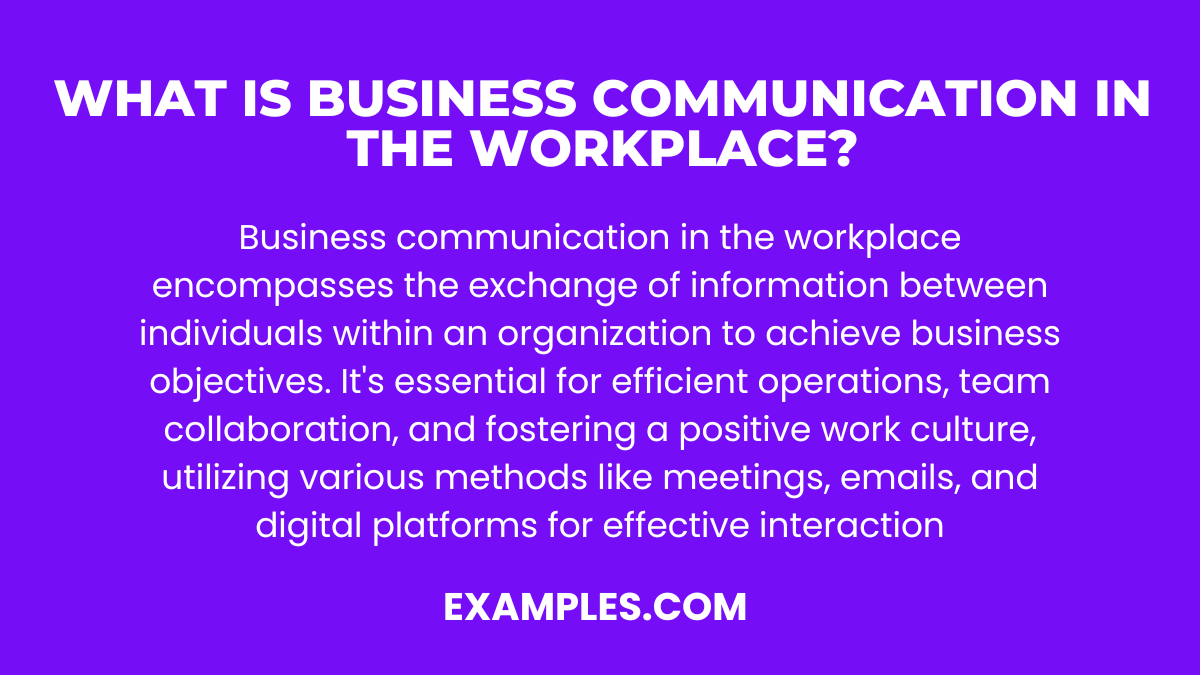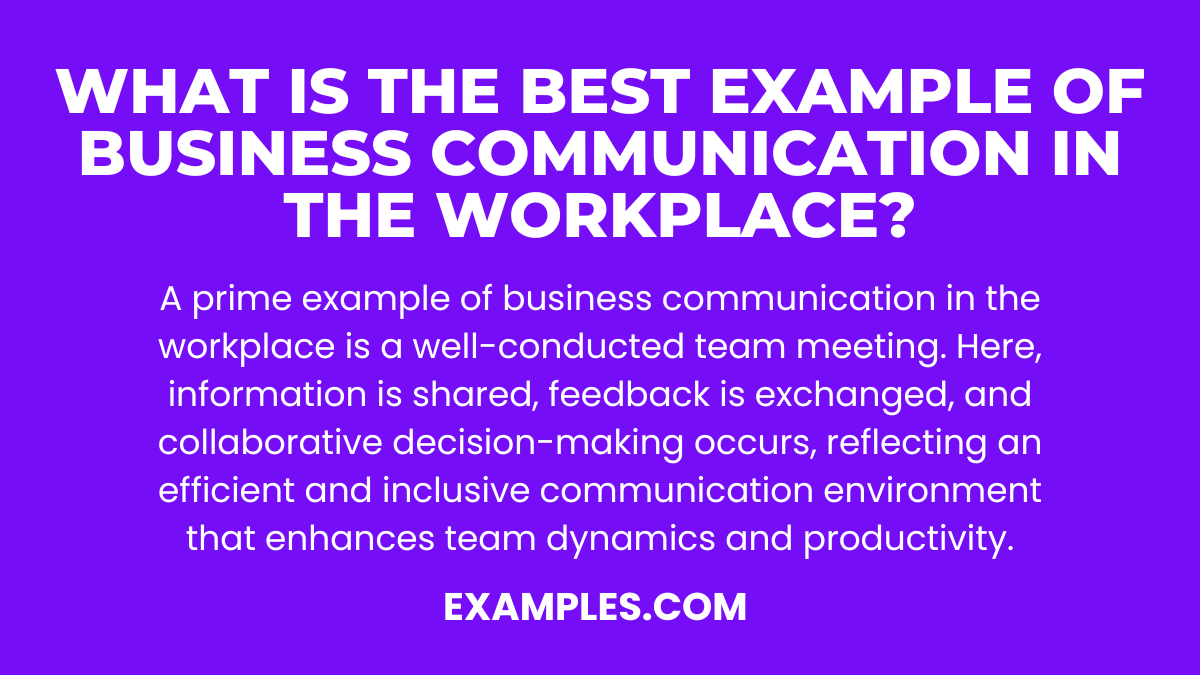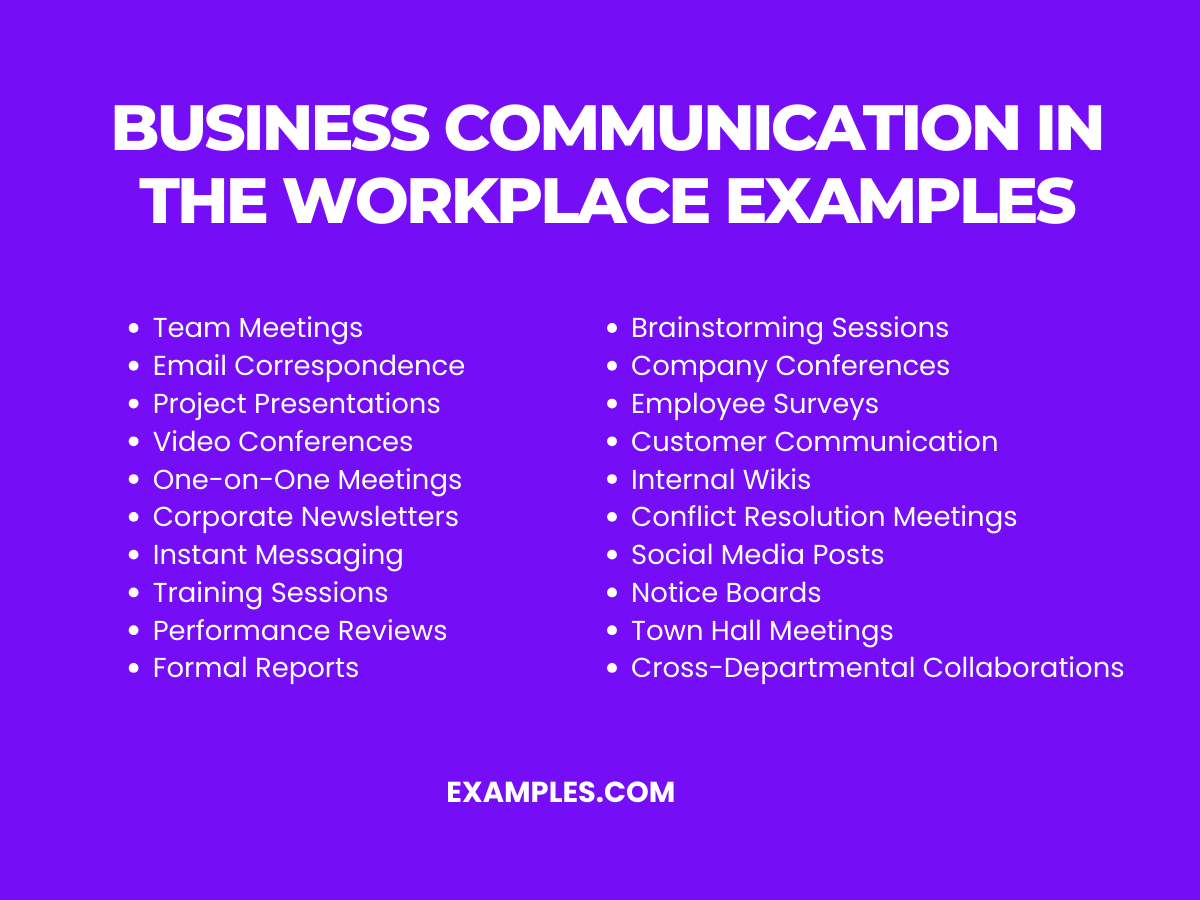40+ Business Communication in the Workplace Examples
Business communication in the workplace is a dynamic and essential aspect of corporate success. This complete guide offers a deep dive into various communication styles, methods, and their impact on organizational effectiveness. Including real-world communication examples, it highlights the importance of strong interpersonal skills, effective dialogue, and the integration of digital tools in fostering a productive work environment. From enhancing team collaboration to navigating leadership challenges, this guide covers the spectrum of internal and external communication strategies crucial for any business professional.
Download Importance of Business Communication in the Workplace PDF
What is Business Communication in the Workplace?
Business communication in the workplace refers to the various ways in which information is shared and exchanged between individuals within a business environment. It encompasses a range of methods, from face-to-face conversations and digital messages to formal reports and presentations. Effective business communication is crucial for the smooth operation of a company, as it facilitates clear understanding, efficient problem-solving, and productive collaboration among employees and management. This communication can be internal, within the organization, or external, with clients and stakeholders.
What is the best Example of Business Communication in the Workplace?
One of the best examples of effective business communication in the workplace is regular team meetings. These meetings serve as a platform for open dialogue, where team members can discuss ongoing projects, share updates, and address challenges. They exemplify clear and structured communication, fostering a sense of collaboration and transparency. Through these meetings, employees stay aligned with company goals, understand their individual roles better, and feel more connected to the wider organizational objectives. This type of communication is key in building a cohesive team and ensuring everyone is on the same page.
20 Business Communication in the Workplace Examples
In the modern workplace, effective business communication is key to success. This essential aspect encompasses a variety of methods and styles, each impacting the work environment differently. From digital communication to interpersonal interaction, the way information is shared can greatly influence team dynamics, project outcomes, and overall workplace morale. In the following guide, we’ll explore 20 distinct examples of business communication in the workplace, detailing their causes and suggesting ways to enhance or mitigate their effects. By understanding these examples, businesses can foster better communication practices, leading to improved collaboration and productivity.
- Team Meetings: Encourage open discussions and alignment with goals. Cause: Need for regular updates and team cohesion. Fix: Regular scheduling and clear agendas.
- Email Correspondence: Main mode of written communication. Cause: Convenience and documentation. Fix: Clear, concise language and timely responses.
- Project Presentations: Share project progress and gather feedback. Cause: Need for visual and detailed project updates. Fix: Engaging content and interactive sessions.
- Video Conferences: Connect remote teams. Cause: Geographical dispersion. Fix: Reliable technology and pre-planned agendas.
- One-on-One Meetings: Personalized feedback and discussion. Cause: Individual performance management. Fix: Open dialogue and constructive feedback.
- Corporate Newsletters: Update employees on company news. Cause: Keeping staff informed. Fix: Regular distribution and engaging content.
- Instant Messaging: Quick, informal communication. Cause: Immediate information sharing. Fix: Appropriate use and response etiquette.
- Training Sessions: Skill development and knowledge sharing. Cause: Ongoing employee development. Fix: Interactive and relevant content.
- Performance Reviews: Assess and guide employee performance. Cause: Career development and feedback. Fix: Honest, constructive discussions.
- Formal Reports: Detailed analysis and information. Cause: Requirement for in-depth documentation. Fix: Clear structure and comprehensive data.
- Brainstorming Sessions: Foster creativity and problem-solving. Cause: Need for innovative ideas. Fix: Open and inclusive environment.
- Company Conferences: Large-scale corporate communication. Cause: Annual updates, networking. Fix: Engaging speakers and relevant topics.
- Employee Surveys: Gather employee feedback. Cause: Understanding employee satisfaction. Fix: Anonymity and action on feedback.
- Customer Communication: External communication for feedback and sales. Cause: Client relationship management. Fix: Professionalism and responsiveness.
- Internal Wikis: Knowledge sharing and resource centralization. Cause: Easy access to information. Fix: Regular updates and user-friendly design.
- Conflict Resolution Meetings: Address and resolve workplace conflicts. Cause: Interpersonal issues. Fix: Mediation and open communication.
- Social Media Posts: Company updates and branding. Cause: Marketing and public relations. Fix: Consistent messaging and audience engagement.
- Notice Boards: Informal updates and announcements. Cause: Localized information sharing. Fix: Current and relevant postings.
- Town Hall Meetings: Company-wide updates from leadership. Cause: Transparency and employee engagement. Fix: Open Q&A and clear communication.
- Cross-Departmental Collaborations: Enhance cross-functional understanding. Cause: Project collaboration. Fix: Clear roles and open communication channels.
Business Communication Strategies in the Workplac
Effective business communication strategies in the workplace are essential for fostering a productive environment. They involve clear, concise messaging and the use of various digital and interpersonal channels to enhance understanding and collaboration among employees. Implementing these strategies helps in resolving conflicts, ensuring transparency, and boosting overall productivity.
- Open-Door Policy: Encouraging employees to freely express their ideas and concerns.
Example: “Feel free to share your thoughts with me anytime; my door is always open.” - Regular Team Meetings: Holding weekly or daily meetings to discuss progress and issues. Example: “Let’s gather tomorrow morning to update each other on our current projects.”
- Email Newsletters: Distributing company updates via email to keep everyone informed. Example: “Check your inbox for the latest company news and updates.”
- Feedback Sessions: Conducting regular feedback sessions to discuss performance and areas of improvement.
Example: “During our feedback session, let’s talk about your recent project successes and challenges.” - Communication Training Workshops: Organizing workshops to improve employees’ communication skills.
Example: “Join our workshop to enhance your communication skills for better teamwork.” - Collaboration Tools: Utilizing digital tools like Slack or Microsoft Teams for instant communication.
Example: “Please post your updates on Teams so the entire team can stay in the loop.” - Mentorship Programs: Pairing employees with mentors for guidance and better communication.
Example: “Your mentor can help you navigate through complex project requirements.” - Town Hall Meetings: Hosting company-wide meetings to discuss major updates or changes. Example: “We’ll be discussing the new company policy in the upcoming town hall meeting.”
- Idea Boxes: Placing suggestion boxes in the office for anonymous feedback and ideas.
Example: “Feel free to drop your innovative ideas in the idea box by the cafeteria.” - Cross-Departmental Meetings: Encouraging interaction between different departments for broader perspectives.
Example: “Let’s have a joint meeting with the marketing team for a more comprehensive strategy”.
Purposes of Business Communication in the Workplace
Business communication serves vital roles in the workplace, encompassing everything from day-to-day operations to long-term strategic planning. It’s instrumental in enhancing team communication techniques, fostering interpersonal skills in business, and streamlining internal corporate communication practices. Let’s explore the five most common purposes:
- Information Sharing: Central to any business, information sharing keeps everyone on the same page. For example, a manager might say,
“Let’s discuss the new project guidelines in today’s meeting.” - Decision Making: Effective communication aids in collaborative decision-making processes. An instance is when a team leader says,
“We need everyone’s input before finalizing our marketing strategy.” - Problem Solving: Communication is key in identifying and resolving workplace challenges. A common scenario could be,
“Let’s analyze the reasons behind our project delay and find a solution together.” - Building Relationships: Strong communication fosters positive relationships among colleagues. A simple interaction like,
“Great work on the presentation, your efforts really stand out!” can boost morale. - Instruction and Training: It is essential for guiding employees, especially new hires. An example would be,
“This is how we handle client queries, let’s walk through the process.” - Feedback Provision: Regular feedback helps in personal and professional growth. For instance, “Your report was excellent, but let’s work on making the summary more concise.”
- Persuasion and Influence: Persuasive communication can motivate and inspire action. A leader might say,
“If we hit our targets this quarter, we’ll set a new company record. Let’s give it our all!” - Conflict Resolution: Clear communication is crucial in resolving misunderstandings or disputes. An example could be,
“I understand your perspective; let’s find a common ground to resolve this issue.” - Brand Representation: Employees often represent their company’s brand, making their communication pivotal. For example,
“As a representative of our company, I ensure to communicate our values to our clients.” - Motivation and Encouragement: Positive communication can significantly boost team spirit. A motivational statement could be,
“Your dedication is the driving force behind our team’s success. Keep up the great work.”
What are Methods of Busniness Communication in the Workplace?
In the realm of business, effective communication is the cornerstone of success. The methods of business communication in the workplace vary widely, adapting to technological advancements and diverse workplace environments. Here, we explore the most prominent methods, each playing a crucial role in facilitating smooth business operations and fostering a collaborative work culture.
Face-to-Face Communication
The most traditional and personal method, face-to-face communication, involves direct interaction between individuals. It’s essential for building trust, understanding non-verbal cues, and handling sensitive topics. Regular meetings, one-on-one sessions, and impromptu discussions fall under this category.
Written Communication
This method includes emails, reports, memos, and business letters. Written communication is ideal for maintaining records, giving detailed instructions, and conveying formal messages. It’s crucial in ensuring clarity and providing reference material for future use.
Electronic Communication
In the digital age, electronic communication has become indispensable. Tools like Slack, Microsoft Teams, and Zoom facilitate instant messaging, video conferencing, and collaborative work across different geographical locations. They’re instrumental in connecting remote teams and enabling real-time collaboration.
Telephone Conversations
Despite the surge in digital platforms, telephone conversations remain a key communication tool, especially for quick discussions or when immediate feedback is needed. They provide a more personal touch than emails and are faster than arranging face-to-face meetings.
Social Media
Platforms like LinkedIn, Twitter, and Facebook are increasingly being used for business communication. They are excellent for brand promotion, networking, and engaging with a broader audience. Social media also provides a platform for informal employee interactions, enhancing team bonding.
Notice Boards and Bulletins
In many workplaces, physical notice boards or digital bulletins are used to disseminate information. They are effective for announcements, policy updates, and general information sharing that doesn’t require immediate feedback.
Presentations
Presentations, whether in-person or virtual, are used for pitching ideas, training sessions, and sharing strategic plans. They combine visual and verbal communication, making complex information more understandable.
Non-Verbal Communication
Often overlooked, non-verbal communication like body language, gestures, and facial expressions play a significant role in conveying attitudes and emotions. They complement verbal communication and can significantly impact the interpretation of the message.
Feedback Mechanisms
Feedback is vital for continuous improvement. Suggestion boxes, surveys, and review meetings are common methods to gather and provide feedback within the workplace, ensuring that communication is a two-way process.
How to Overcome Business Communication in the Workplace Barriers?
Overcoming communication barriers in the workplace is essential for ensuring effective corporate communication strategies and maintaining interpersonal skills in business. Here are strategies to address and mitigate these barriers:
- Foster an Open Communication Culture: Encourage an environment where employees feel comfortable sharing ideas and concerns. This openness is crucial for effective workplace dialogue.
- Provide Communication Skills Training: Regular training sessions can enhance team communication techniques and professional interaction styles, equipping employees with the skills needed to communicate effectively.
- Utilize Clear and Concise Messaging: Adopt business messaging tactics that are straightforward and to the point. This approach helps in avoiding misunderstandings and ensures that the core message is conveyed accurately.
- Encourage Active Listening: Promote a culture where listening is as valued as speaking. Active listening plays a significant role in interpersonal communication, helping to understand and resolve issues more effectively.
- Leverage Digital Communication Tools: Make use of digital communication platforms to bridge the gap between different teams, especially in cross-functional settings. This enhances cross-functional communication in companies.
How Can I Improve Communication Skills in the Workplace?
Practice active listening, provide clear and concise information, be open to feedback, and regularly engage in team-building activities.
What is the Impact of Poor Communication in the Workplace?
It can lead to errors, decreased morale, conflict, and reduced productivity.
Effective workplace communication is a fundamental pillar in the business world. It serves as the lifeline of a well-functioning organization. Good communication in the workplace helps streamline workflows, fosters a positive work environment, and enhances overall productivity. When employees and management communicate effectively, it leads to improved team collaboration, greater understanding of roles and expectations, and a more engaged workforce. Additionally, it minimizes misunderstandings and potential conflicts, thereby facilitating a smoother operational flow.






